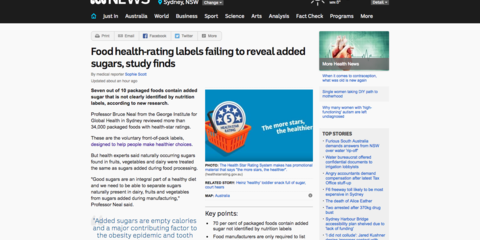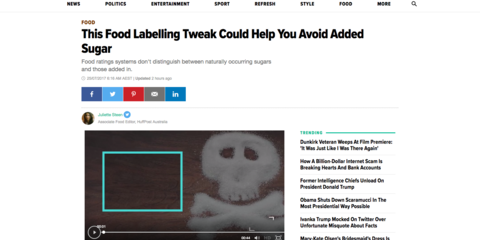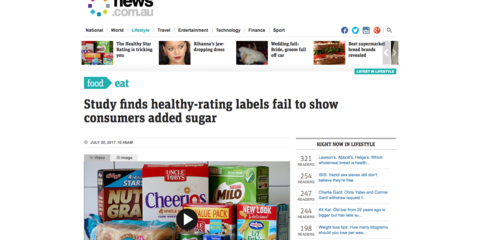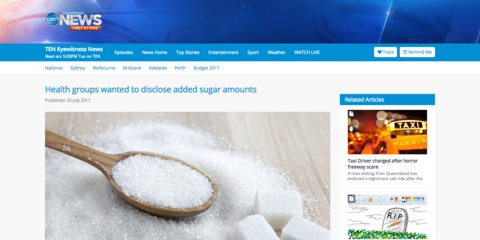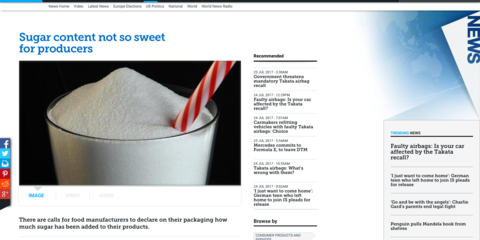
Hidden sugars unmasked on Australia’s supermarket shelves
A new study by The George Institute for Global Health has revealed around 70 per cent of packaged foods contain added sugar.
The findings published in Nutrients highlight the need for added sugar to be declared on packaging and used in the Health Star Rating front-of-pack labelling system. Under the current system only total sugar needs to be reported on food labels and used in the HSR calculation.
Professor Bruce Neal, of The George Institute for Global Health, said there was a clear need to differentiate between added sugars and total sugars. "Good sugars are an integral part of a healthy diet and we need to be able to separate sugars naturally present in dairy, fruits and vegetables from sugars added during manufacturing.
"Added sugars are empty calories and a major contributing factor to the obesity epidemic and tooth decay. Australians would be much better off if they could quickly and easily see how much sugar has been added.”
Researchers from The George Institute analysed more than 34,000 packaged foods - 18,350 discretionary and 15,965 core foods - to discover how the HSR could be improved if added sugars were used in the algorithm. Core foods are foods that form the basis of a healthy diet. In contrast, discretionary foods are energy-dense and nutrient-poor and include foods and drinks not necessary to provide the nutrients the body needs.
Using Australian Dietary Guideline definitions, they found 87 per cent of discretionary foods included added sugars, compared to 52 per cent of core foods. And discretionary foods such as cakes, pies, ice cream, pastries, processed meats, potato chips and soft drinks contained on average almost four times more added sugar than core foods such as cheese, milk, bread, yoghurts or plain cereals like oats.
Co-author Dr Sanne Peters, of The George Institute, said the results clearly showed that using added sugar instead of total sugar to calculate the HSR resulted in much better alignment between core and discretionary foods. "One of the key criticisms of the HSR has been that it doesn’t always align with Australian Dietary Guidelines. Using added sugars instead of total sugars means it does a much better job of this.’’
This was particularly so for discretionary products such as muesli bars, jam, rice puddings, and chutney and other sauces and spreads, which contain a lot of added sugar but get a relatively high HSR in the current system.
Dr Peters added: “The World Health Organisation and dietary guidelines around the world focus on the problems of added sugars so it’s not at all surprising that using added sugars in the algorithm does a better job. The United States has announced a requirement for routine labelling of added sugars and it looks like it would be a good move for Australia too.’’
The research will be submitted to the Government’s current review of the HSR system.
Professor Neal added: “Australia has a world-leading food labelling program in the Health Star Rating system. The HSR gives great advice most of the time but has been criticised for a few high-profile anomalies. One of the key challenges relates to added sugars and we have shown here how it can be fixed. We’d encourage food manufacturers to start labelling added sugars and government to provide the framework.”
Sugary facts
- There are at least 42 different names used on food labels for added sugar including sucrose, muscavado and turbinado.
- The Australian Dietary Guidelines recommend that just 10 per cent of an adult’s diet should come from added sugar. However at least 50 per cent of the population consume more.
- Soft drinks, energy and sports drinks, as well as fruit and vegetable juices make up 32 per cent of the added sugars in our diets.
- In the United States food manufacturers will have to include both total and added sugars on food labels from 2018.
- In April consumer group Choice released a report which found that if consumers could identify added sugars on food packs they could avoid 26 teaspoons of sugar each day and up to 38.3 kilograms a year.






